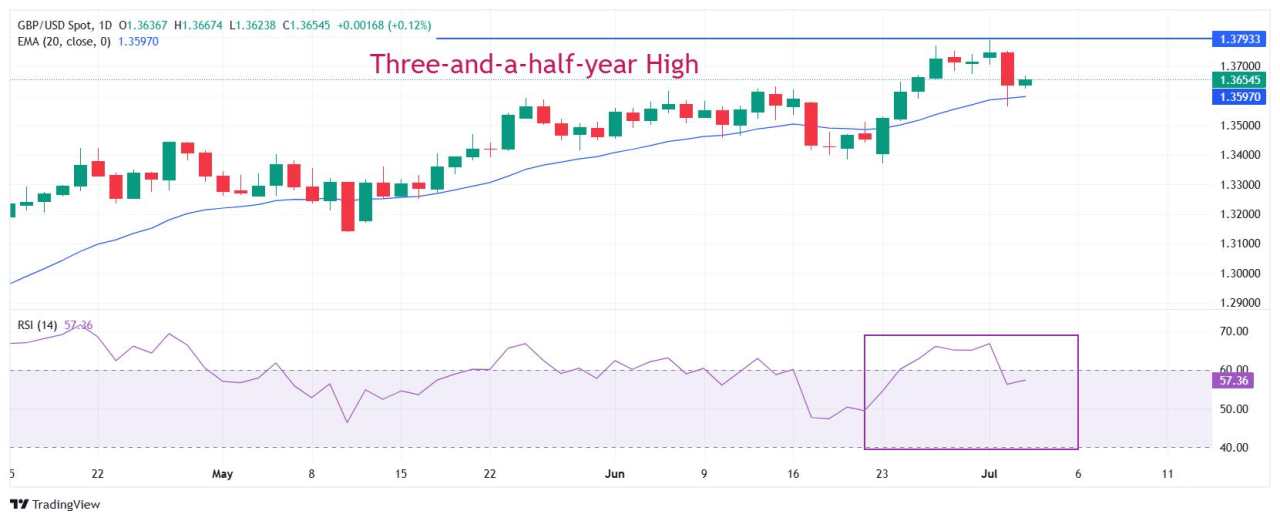- The Pound Sterling oscillates in a tight range around 1.3650 against the US Dollar after falling by a sharp 0.8% on Wednesday.
- Investors dumped UK assets, including the Pound, amid political jitters surrounding UK Chancellor Rachel Reeves.
- Surging UK bond yields due to higher welfare benefits have weighed on the Pound Sterling.
The Pound Sterling (GBP) trades in a tight range around 1.3650 against the US Dollar (USD) during European trading hours on Thursday. The GBP/USD pair seems to have found a floor after Wednesday's slump, in a broad sell-off in UK assets due to growing question marks around the continuity of Chancellor of the Exchequer Rachel Reeves.
The Pound, which fell more than 1% before paring some losses, regained some ground after Prime Minister Keir Starmer said that Reeves – who is seen by markets as a big defender of fiscal rules – would continue in her post.
Looking at the economic calendar, investors await the United States (US) Nonfarm Payrolls (NFP) data for June, which will be published at 12:30 GMT.
Investors will closely monitor the US employment data as comments from a few Fed officials, including Vice Chair for Supervision Michelle Bowman, have signaled increasing labor market risks.
“It is time to consider adjusting the policy rate,” Bowman said in the last week of June and added, “We should put more weight on downside risks to the job market going forward.”
According to the estimates, the US economy added 110K fresh workers, fewer than 139K in May. The Unemployment Rate is estimated to have accelerated to 4.3% from the prior reading of 4.2%.
Meanwhile, the Average Hourly Earnings data, a key measure of wage growth, is expected to have grown steadily by 3.9% on year. Month-on-month wage growth measure is estimated to have risen at a slower pace of 0.3%, compared to a 0.4% growth seen in May.
Signs of softening labor market conditions would allow traders to raise bets supporting early interest rate cuts from the Fed. On the contrary, upbeat numbers would allow Fed officials more time to assess the impact of new economic policies announced by US President Donald Trump on the economy.
Daily digest market movers: Pound Sterling struggles amid surging bond yields
- The Pound Sterling strives to stabilize against its peers on Thursday after underperforming in first three trading days of the week, following a sharp surge in United Kingdom (UK) gilt yields.
- 10-year UK gilt yields surged 17 basis points (bps) or almost 4% to near 4.61% on Wednesday after Prime Minister Keir refrained from backing Chancellor of the Exchequer Rachel Reeves till next elections, following the announcement of an increase in welfare schemes by the government. However, PMI Starmer stated later that “She [Chancellor Reeves] is going nowhere”.
- The Downing Street increases standard allowance for Universal Credit (UC) to provide additional support to low-income households, which has become effective this month. The welfare bill introduced at the House of Commons this week has put Chancellor Reeves’ fiscal commitment into question after vowing to cut benefits in the Autumn statement to strengthen country’s fiscal position.
- New welfare reforms are expected to wipe out governments’ plans to save £5.5 billion by 2029-2030, which it decided to raise through reducing the UC health element for new claimants, according to data from UK Institute for Fiscal Studies (IFS).
- Higher borrowing costs for the UK government at a time when the economy is battling with global trade war risk have jeopardized the economic outlook.
- On the monetary policy front, Bank of England (BoE) policymaker Alan Taylor has supported five interest rate cuts this year against four as anticipated by market participants, citing downside economic risks in 2026 due to demand weakness and trade disruptions, while speaking at the European Central Bank (ECB) summit in Sintra on Wednesday. Taylor was one of three BoE officials who supported an interest rate cut in the June policy meeting.
Technical Analysis: Pound Sterling holds 20-day EMA

The Pound Sterling trades sideway to near 1.3650 against the US Dollar on Thursday. The GBP/USD pair recovers after sliding to near the 20-day Exponential Moving Average (EMA), which trades around 1.3600.
The 14-day Relative Strength Index (RSI) falls below 60, suggesting that the bullish momentum has faded.
Looking down, the psychological level of 1.3500 will act as key support zone. On the upside, the three-and-a-half-year high around 1.3800 will act as key barrier.
Pound Sterling FAQs
The Pound Sterling (GBP) is the oldest currency in the world (886 AD) and the official currency of the United Kingdom. It is the fourth most traded unit for foreign exchange (FX) in the world, accounting for 12% of all transactions, averaging $630 billion a day, according to 2022 data. Its key trading pairs are GBP/USD, also known as ‘Cable’, which accounts for 11% of FX, GBP/JPY, or the ‘Dragon’ as it is known by traders (3%), and EUR/GBP (2%). The Pound Sterling is issued by the Bank of England (BoE).
The single most important factor influencing the value of the Pound Sterling is monetary policy decided by the Bank of England. The BoE bases its decisions on whether it has achieved its primary goal of “price stability” – a steady inflation rate of around 2%. Its primary tool for achieving this is the adjustment of interest rates. When inflation is too high, the BoE will try to rein it in by raising interest rates, making it more expensive for people and businesses to access credit. This is generally positive for GBP, as higher interest rates make the UK a more attractive place for global investors to park their money. When inflation falls too low it is a sign economic growth is slowing. In this scenario, the BoE will consider lowering interest rates to cheapen credit so businesses will borrow more to invest in growth-generating projects.
Data releases gauge the health of the economy and can impact the value of the Pound Sterling. Indicators such as GDP, Manufacturing and Services PMIs, and employment can all influence the direction of the GBP. A strong economy is good for Sterling. Not only does it attract more foreign investment but it may encourage the BoE to put up interest rates, which will directly strengthen GBP. Otherwise, if economic data is weak, the Pound Sterling is likely to fall.
Another significant data release for the Pound Sterling is the Trade Balance. This indicator measures the difference between what a country earns from its exports and what it spends on imports over a given period. If a country produces highly sought-after exports, its currency will benefit purely from the extra demand created from foreign buyers seeking to purchase these goods. Therefore, a positive net Trade Balance strengthens a currency and vice versa for a negative balance.
作者:Sagar Dua,文章来源FXStreet,版权归原作者所有,如有侵权请联系本人删除。
风险提示:以上内容仅代表作者或嘉宾的观点,不代表 FOLLOWME 的任何观点及立场,且不代表 FOLLOWME 同意其说法或描述,也不构成任何投资建议。对于访问者根据 FOLLOWME 社区提供的信息所做出的一切行为,除非另有明确的书面承诺文件,否则本社区不承担任何形式的责任。
FOLLOWME 交易社区网址: www.followme.ceo


加载失败()